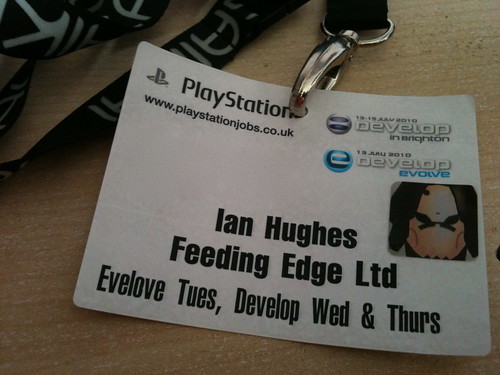I recently joined the panel at the Train for Success event in Second Life where we (Anders the host, Dusan Writer, Maria Korolov and myself) were there to discuss the pulling back from pure enterprise firewalled virtual world solutions by Linden Lab and a focus on the consumer experience. In part of that we talked about the various game related technologies that come into play in delivering a virtual world. Lots of the focus, quite naturally, is on the front end though I did point out the challenge of any MMO is the server based synchronization. In many ways we can get a browser or client to do all sorts of wonderful immersive stuff but its much harder to share a lag free experience and distribute to those clients.
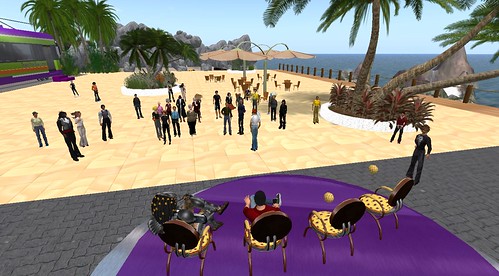
It was interested to take the role of the “techy who knows a bit about game platforms”.
All of us responded in pretty much the same way that yes enterprise SL was not packaged and sold right, nor given the time to evolve but that we all use Second Life still as we blend business and social in so many ways. It was where I started to get traction with my colleagues and customers in 2006.
At the end we got onto what needs to extend to an even more interesting conversation as whilst the technology can continue to evolve and get better, faster etc it is the things we do with it and the creative endeavours that create interest and engage people.
Whilst there was an uphill battle to get the more mainstream business people to get over the apparent frivolous nature of avatar mediated communication this next wave is really go to scare them and challenge them.
Many of the IT departments and policy makers have decided “We don’t play games at work on our PC’s” that is the mantra used to block the use of anything remotely interesting. It is not without some reason, but the seed of reason grows into a giant forest of objection and darkness. Explaining, or showing that places like Second Life and Opensim etc are not games, just game technology used for another reason doesn’t always chop down the forest.
Now of course there is the gamification wave. The implementation of game mechanics and ideas into every application and walk of life. Business is a game, saying the right things to get that promotion is a game, getting the promotion is a badge earned and worn, winning the sales competition and going on a jolly is like a rewarding cut scene after a tough mission.
Many of these game mechanics, remembering the IT department “we don’t play games at work” mantra will not even touch any of the IT systems in a way they will notice. An Alternate reality campaign inside a corporation may use the phone system, emails, noticeboards etc. All hiding the game elements as a payload inside everyday tools.
At some point though, someone, somewhere, is going to say why cant we do this in a wonderful hi rez generated environment? Why cant we use gesture control like Kinect to navigate the sales figures.
It is a conceptual revolution with a massive social impact, as much as social media and the web. Screwing together plates on a production line is very hard to alter as a physical process to make it less soul destroying. Motivations of speed and efficiency and money for the worker help but ultimately it gets automated. The digital chores we make for ourselves clearly can be altered, you have a family photo as a backdrop on your desktop as a start.
There is a great article from the Harvard Business Review here I know statistics don’t work for the closed of mind as they will discount things that do not meet their believes but this is an interesting quote.
“At SCVNGR, we’ve been able to examine the statistical effects of introducing game dynamics into situations that are decidedly not games. We’ve seen simple game dynamics increase traffic to locations 4X over a matter of days. We’ve seen others extend the average amount of engaged time consumers spend at a business by upwards of 40%.”
Game mechanics motivate and entertain people. People pay to play games that are chores. Surely its in all the more straight laced and ROI induced business people to look at what they and their people do and see if they can spruce it up a bit. Bored or scared people are going to just do the least they need. Motivated and excited people are going to do great things.
So straight laced serious business people who use ‘this is the way we have always done it” whats the point of that…. people the ball is in your court (oh look another gaming/sporting reference).
games
Unity3d, F1, Google Maps mashup
A very neat application surfaced this weekend via tweets by @robotduck. An official Vodafone F1 application lets you build the profile of a track you race from the roads on google maps.
Its called Hometown as they clearly have spotted most people will razz around racetracks near their own homes.
Not only that they let you add extra furniture to the tracks, landmarks and barriers, including yout own text banners.
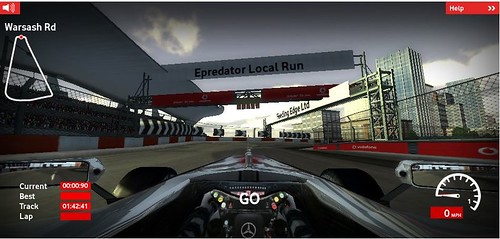
It is very cool and uses unity3d
Pushing the envelope – Literally
After recording the Cool Stuff Collective second episode using the Haptic 3d device it made sense to get one and see what the predlets, and maybe their school, could do with one. Whilst the haptic show does not air until 20th September I thought it was worth sharing some initial impressions of ownership. Basically it awesome !
The entire package is called Chameleon 3d from A1 Technologies. A1 Technologies are the UK distributor of both the Novint Falcon (The haptic device) and the Anarkik3d Cloud 9 modelling package
The Falcon has a self contained set of mini games and tutorial demos. Although windows drivers tend to be a bit of a pain if you follow the right instructions it dos just work first time. The initial demo lets you feel a number of textures and forces rough, smooth, magnetic, rubber, honey etc. It makes for a very impressive feel for the potential.
Whilst I did spark up the haptic patch for Half Life 2 I was more interested in the creative modelling of Cloud 9 for the moment (more on virtual world and game navigation in another post)
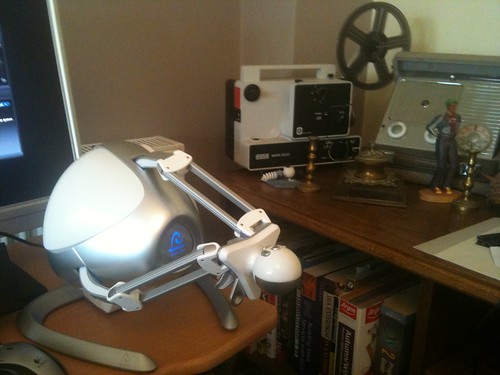
Here is the Falcon nestled with some much older tech gadgets.
The Falcon is quite a large device but sits on a nice sturdy base. It needs some weight to be able to offer resistance and not zoom across the desk. The footprint is about the same as the old microsoft sidewinder force feedback sticks I used to have for Combat Flight Sim.
On Cloud9 I dived straight in and in time honoured tradition “it all started with a cube”.
I pushed, prodded and deformed the cube both from the outside and from the inside too.
The video shows the resulting modified cube, then it published to Unity3d as an OBJ file. Finally it shows predlet 1.0 having a go. It really is very intuitive and very compelling to model with. I have a few ideas of things I want to try but like any modelling tool that also needs some inspiration and talent. As the creation can be exported as OBJ (or STL if you want to 3d print them) then can of course be put into other 3d packages to have extra effects applied.
Now when are Second Life going to sort out meshes 😉 I can generate some very organic structures then even as a techie.
If you want to see the actual unity3d spin around it is here I published it from the free windows version as my Mac paid for version is on the version 3 beta and so cant publish to the web yet.
BTW it was using this that predlet 1.0 uttered the immortal words “Dad, I love you job its way cool” 🙂
Fiducial Markers and Unity 3d
I was looking around for a quick way to use the wonderful Reactivision camera based marker tracking. Ideally I really wanted a fully working Reactable, but without a projector and the music and light software and the physical elements like a glass table I cant really do what I want to do in the time I need to do it.
I bumped into a project from a few years ago the tangiblaptop that was aimed at using the laptop screen rather than a projector to display the things that happen to the markers that are also placed on that surface but picked up by the camera. It looked good but I thought I needed something with a bit more variety.
Then I saw this Uniducial . A small library and and couple of scripts to drop into Unity3d.
Within seconds I had objects appearing and disappearing based on the markers they could see in the camera view.
(I have done a few things with these before as did Roo back in the day
However I think the unity3d gadget is going to be very useful indeed 🙂
Family gaming – in context options, why not more of them?
I have been considering the PEGI and content ratings of games more than usual recently due a project I am working on. Having to make sure that things are not 12 or over is actually quite a challenge in gaming circles.
Much of this seems to be not just related to violence but to the language used. Games actually offer a great deal more flexibility with clever design to be able to be adjusted to the right age range without losing some of their coolness and anarchy.
A prime example is the excellent Rock fest that is Brutal Legend
Whilst playing the intros it challenges you to make some option decisions about the type of content you would like to experience.
In the scheme of things Brutal Legend is a mission based beat-em-up and RTS but heavily themed with Rock imagery. The main character is played by Jack Black. There is a fair amount of hitting things and casting spells but I have found the predlets have enjoyed watching most of it. In particular they loved Ozzy Osbourne shout rock and roll and throwing the sign of rock. The music is great and whilst they dont actually play it I am happy for them to see its cartoon brilliance on screen whilst I play.
At the start of the game I was asked if I wanted the profanity or the other option of “it sounds funnier when it bleeped out”. With the predlets around that seemed better, and it was funnier.
As you can see below there is also an option to turn off the “gore” which is games terms is not really much more than watching Ben 10 as it is so cartoony yet funny. However the option is there to turn it off
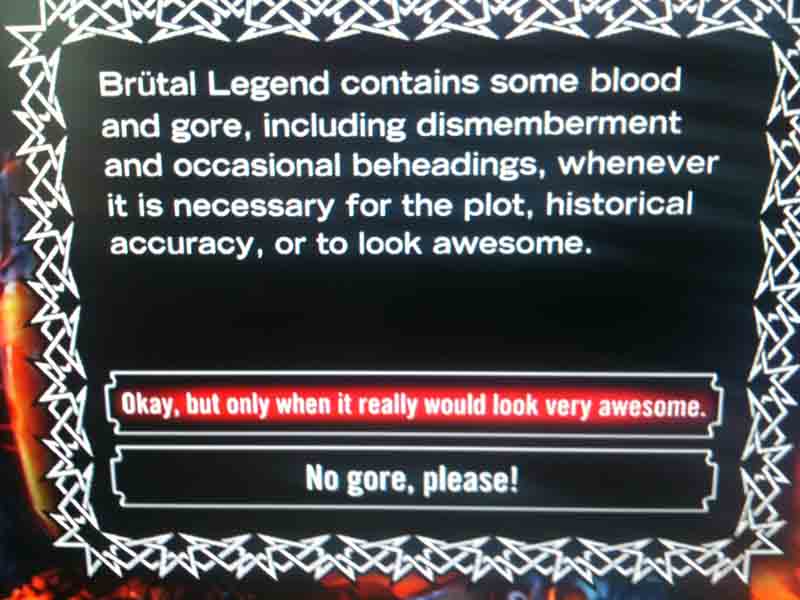
Other media, films, books etc are not able to adjust or be able to be toggled like this.
If a few more things tried this, in particular with dialogue, then I would be able to let my predlets see and play a few more quality games.
This does not stop the fact the content is in there to be unlocked of course so some parental responsibility comes into it, and there is still room for pure 15+ or 18 entertainment, but some of it is so borderline we should be able to choose and turn some features off.
The game changing in games – gamification
I was recently considering what the cycle of evolution has been in the games industry and why it is a struggle for some to see the scope of the change, whilst to others it is obvious.
I drew this picture to illustrate the evolution of not just the technology but of the social aspects of gaming.
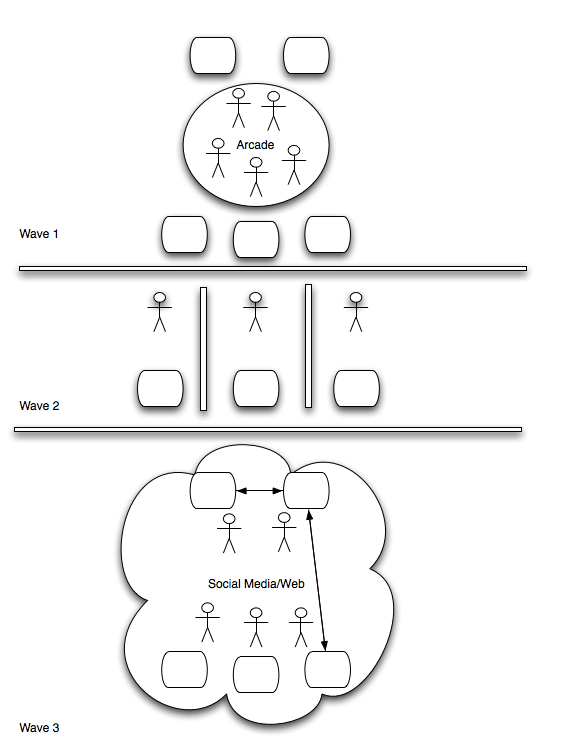
It stems from the origins of the games arcade. Illustrated in Wave 1 above.
The arcades were places that people gathered, they were social hubs, even if many of the orginal arcade games were not really multiplayer. Of course asynchronous turn taking 1up and 2up etc were built into the earliest arcade games. High score tables were prevalent.
The arcades were viewed by many as the “Pool Hall” of my generation, feared as places kids hung out and got up to no good. However they were great places. Anyone go go in and try.
When the home computer revolution started in the early 80’s many of us were amazed that we were able to reproduce or create those same gaming experiences in the comfort of our own home. We did not have the ability, other than via posting tapes and disks or via magazine listings to share the creative work, but it did happen. Games companies formed out of many of these self organizing groups of people.
However in the consumer space that led to wave 2 above. People in their homes, separated with no connection to one another. Yes there were LAN parties and still the 1UP 2UP games but in general the LAN parties were not something everyone did. It required a certain commitment and technical expertise to go and join in. Wave 2 started to cater to the hardcore gamer based on the sort of experience that works best in isolation.
There was a quiet evolution going on, the web was forming, the MMO genre was forming, bulletin boards and early web pages started to share content between people. However it was still quite insular and and scary place for the non tech literate. Unlike an arcade you could not just wander in drop 10p and have a quick go.
Then of course the internet started to become all encompassing. Consoles started to connect, the PC world was already hooking up to replace the LAN party. More importantly though many game experience evolved, the casual games, that people could just have a quick go. If you had a computer and a connection, you could wonder in and drop your virtual 10p into a slot.
The barrier to entry to games dropped significantly, which also increased the acceptance.
More importantly though the web and social media have now become the new arcade. It is a socil space where various results of different games experiences jostle with one another just as the sounds of Space Invaders battle with the ripping noises of Defender in the old arcades. Genre’s sit virtually next to one another and people are once again connected.
Not just connected through the game mechanic, there are still single player stand alone games, but the results of the games, the joy or frustration are played out in space that is social media. We can feel a gaming atmosphere, just seeing a Farmville achievement flow past on a Facebook status or a tweet from someone enjoying the ending of Red Dead Redemption adds that gaming atmosphere to everything.
This return to the social element, the awareness of others experiences and the sharing of common interests is a cultural win for games. For games developers though this is going to be new.
In wave 1 the arcade consoles were developed and the arcade owners hosted the space. The two were not really tightly linked, one arcade console just happened to be next to another.
With the web arcade we have today the developers have to be cognisant of both the environment they are in and of the other experiences they share that meta space with.
The achievements in games that are shared in these spaces have their currency to the players of the game but also to prospective players and bystanders. In a wave 1 arcade you would (as a novice) have no idea if a score was good on machine x, y or z. Now though the game will produce a badge or certificate to say what you have done is actually really quite good.
It is an exciting time for games and for gamification as it is called. This wave 3 picture is the eco system it drops into, as much about people as the technology.
Unity 3 demo – Impressive stuff
@C4RL05 recently tweeted this excellent video preview of a demo done in the new Unity 3. It shows the power of the engine, and bear in mind this stuff runs in a browser and iphone and android as well as standalone and games consoles.
Unity Bootcamp from Amilton Diesel on Vimeo.
It is a single player experience, has some great graphic design, but more impressive is this is a free to access engine that anyone can get to develop with. I have the new beta and it is slicker and better than ever
Iphone as a boardgame playing piece?
I had an unusual thought that I tweeted today asking if anyone had used an iphone as a boardgame playing piece. This was in part due to the shuffling of iphones that happens when a number of people are in the same place and all have the same device.
We all have different lockup pictures and things to identify our iphone, almost avatar like. So I wondered if anyone had built a board game where the pieces were common digital devices like the iphone. Note this is not a board game on an iphone, but a boardgame with an iphone.
It struck me that this was a combination of AR, augmenting the board game experience. Ultra local location based services (i.e. not about the map of the country but the map of a small playing board on your dining room table).
This is just a messing around mockup for the sort of thing the piece might be in Monopoly.
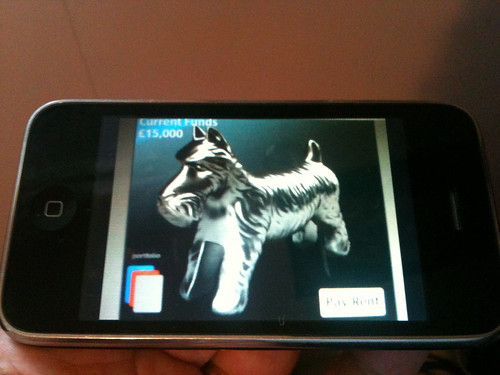
The phone is also very card shaped and tactile and slideable around on a board, but with processing and graphic power to be able to keep a visual tally, or just show some status of the game as it goes along.
It also feel a bit like the Sega Dreamcast console that has a separate player visual memory unit VMU, a personal screen to indicate game information only to the player.
I have not had a good look around yet but I am sure there are flavours of this sort of thing. I think I may also have another twist and use for the idea for a project at the moment.
This may be overkill for certain games but as these handhelds are becoming social gaming hubs it may be we can use the physical aspects of their existence not just the network connectivity. Everywhere is local, including local !
Things I have tried since Develop – Danger, Toys and Zombies
As everyone always says “I don’t have time for x,y,z”. However when it comes to games, virtual worlds, emerging trends and technology I find I have to interact with things and try them out in order to put them in context. Some of the things were just sitting there in some queue, hijacked by other pieces of work. The Develop conference inspired me to go and look at a few things.
1. Bejeweled Blitz on iphone (and other platforms). I find PopCap games brilliantly done, very addictive, but I don’t really want to play them that much. They tend to have the overwhelming feeling they will never end, like a Terminator they will just keep coming. My wife loves them though, and she is rather good at them. Going to the PopCap presentation about Blitz I thought I best have a go on my iphone before the competition to win an iPad. How cool is that, play Bejeweled Blitz for 1 minute (as thats the time limit on the game) highest score wins an iPad. I didn’t win as I am not up to speed on the thing. What blitz does though it make me want to play a bit more. First its only 1 minute at a time, second it publishes the top scores each week amongst your friend on Facebook. So it has some of that asynchronous social gaming in a casual form. So I find myself drawn to it and feel that competition, even though I know I am not up to speed yet i have a target.

1b. Plants Vs Zombies. I put this as related to Blitz as it is a PopCap game. It is another that I had avoided but thought I should give a try after hearing PopCap’s back story. It is a resource management meets space invaders game somewhat like the castle defence genre. It manages to be very addictive and engaging (though has no social component yet). I liked it though, placing plant weapons on a lawn to stop an advancing army of cartoon zombies is suitably mad that it was worth a bit of time playing 🙂
2. Kahoots on PS3 Minis. This is a puzzle platformer out of the Lemmings mould. Also though it is on the PS3 but one of the games that you can drop onto your PSP. So I did. I found myself again compelled to figure out the levels. You know the solution is in there somewhere but with its almost Portal style screen wrap around sometimes the solution is to fall off, which is great.

3. Joe Danger on PS3. Hello Games first foray, a brilliant look to a cartoon style side on bike game. Fluid controls, lots of stunts and combos. It turns out the predlets love it too. It gets a bit tricky but the head to head racing really got them going. Again solving the puzzles, a lot of repeat play make this one cracker of a game. I had seen about it but avoided the PS3 as I was busy on the Xbox. However both Kahoots and Joe Danger sparked my interest in PS3 again.

4. PS3 Home. I had not been in Home for a while again, as I thought there was nothing new to check out. Having talked with a Home developer at one lunchtime session I thought I should go back and check it out. Most of my gamer contacts being on XBL some of the shared spaces I have are not that interesting solo. However I sparked it up, patched it etc and found myself getting the Toy Story 3 “Andy’s Room”. Again this was to see what the predlets thought as much as my interest in how this form of interactive advertising was going to work.
It was somewhat magical to be wandering around, with the added out of context avatar of the predator.
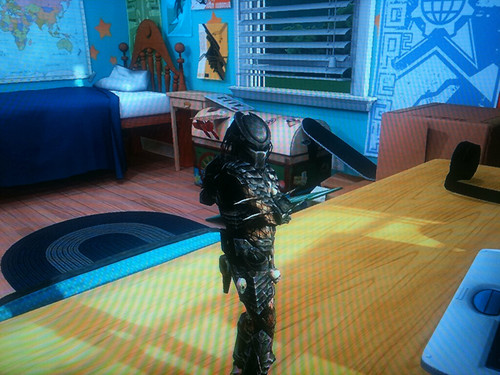
Yes these activities ate into some time, but only a few hours spread over a few days and shared with the family. Seeing how these things engage us socially, become part of our lives is as intriguing as the joy of the various games.
What is not in doubt is the connected nature of these experiences. They are not dumbed down nor less entertaining than a full on AAA hardcore gaming experience. They fit into small slices of time in lifestyles but enhance human bonds.
Day 2 & 3 Develop 2010 – Small is the new big
Day 2 was supposed to start with the guys from Bioware (part EA) with
Creative Game Development: How we do it at Bioware with Dr. Ray Muzyka and Dr Greg Zeschuk.
However there was just one of them. It was quite a rock and roll start for Greg to have to apologise for Ray not being there but he had managed to get himself into the last 500 of the World Series of Poker.
Greg went on to give what was probably an unusual kind of corporate business talk but with a successful and creative game spin to it. As you can see from the pictures if you have ever sat through a corporate powerpoint presentation its pretty much like this. Note the “Interesting Learnings” title.

Having said that it was interesting to see how a small company grew to become a larger one, then get bought by EA (a huge one), then have to merge in other smaller studios under the Bioware brand across multiple locations.
Greg was very articulate and passionate about establishing the culture and the values of a company. (He admitted they had gone off to do MBA’s which explains the ppt). However I think this was not just lip service. I have heard many a corporate spiel on values and been left feeling it was convenient to say those things without backing it up. Equally I have heard, and given, talks with the same true belief in the power of teams and of people.
He indicated that as evolution occurred the culture and people and processes had to adapt but try and stay around the core values. As he also said, this is all obvious but many people do not spend time to consider the structure, who they are and what their way forward is. It sounded as if they had taken a decision early to make sure they both hired for the culture and also indoctrinated the values into those people (in a good way). That formed stronger bonds.
I am not sure who in the audience was into what he was saying though. I was expecting some flashy bang whizz creative explosion on stage, but instead got a very good, very sensible and very articulate presentation on organisational structures.
Next up:
Ed Vaizey : Minister for Culture
It was apparently a new thing for a minister to come and talk, and with all the budget changes little things like tax breaks for the video game industry (another discussion that one) getting dropped there seemed to be some nervousness amongst the organisers that this would all kick off some how. Several intro’s suggested how brave and noble it was for Vaizey to risk turning up. I found that a little patronising to say the least. Vaizey tends to have been a supporter of games and his opening remarks were how the industry attracted people from the “difficult subjects” of computer science, engineering and maths. On a personal note it was hard to listen to him and not think he is like Boris’s coherent brother.
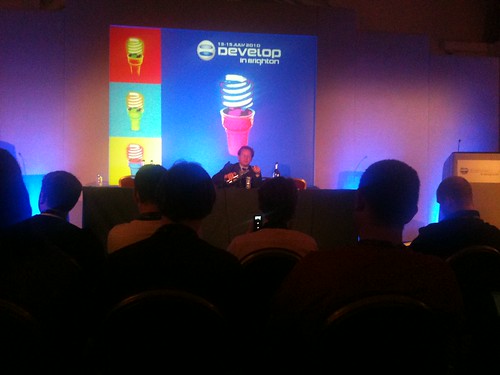
Anyway he read a load of facts and figures, announced some £2million fund out of Abertay for gaming startups, and Ian Livingstone heading up a study or panel on games development education and if it was working. The rest was really just spin, NI contributions, Conservatives good for business etc.
He then sat down and took some questions. Though I do not think there were any specific important answers though somehow it got onto immigration.
He was asked what game he is playing at the moment. There was a ripple of laughter from the audience which may have been the outlet for the sit still children we got at the start. Apparently he is playing “Super Mario on the Wii as that is the limit of what he can do”.
He said he was passionate about the industry, but then he has said that about other things as its a great non action word. He also sang the praises of George Osborne which I suspect was because the whole thing was on TV for the politics show.
The Future IS (changed to Of) Controller Free Games and Entertainment
George Andreas – Changed to Nick Burton of Rare
This was a pitch about Kinect. Rare are close to Microsoft and really the pitch started as a history of what Rare had done and tried out over the years to show they were not simply jumping on the Kinect bandwagon. That may be a little unfair, and certainly Rare have shown a great deal of innovation and cool things over the year, so it may have been part of the corporate theming of the pitch.
Nick recounted some interesting gaming moment from Rare. Including some home brew attempts at the wand approach (way before Sony’s Move)
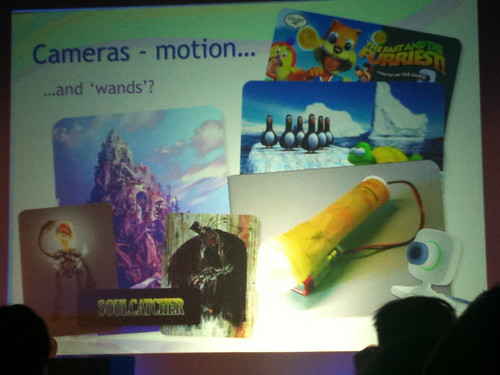
Nick then wen on to talk about Powergloves and a few choice gaming moments, Kameo as a launch title on the 360 etc. The challenged of developing on hardware that is a moving target.
This led onto the core of the pitch. Using Kinect to make a sports game. By getting 3 willing volunteers up on stage and asking them to run on the spot he showed how it is hard to determine what a running movement actually is. Tight arms in knees up running and a sort of Manchester waddle of running being two extremes.
He then went into some depth about altering gameplay and the essence of a game to fit with a comfortable way to play. This centered around football (as in soccer). Running and navigating a 3d pitch whilst possible turned out not to work well from an experience point of view. The essence of football seemed to them to be the set pieces and the kicking of the ball. The long and short of it is really to make football a bit like netball on Kinect. You kick the ball with your body, but don’t run around simply turn your shoulders to face the player you pass to. This is a very practical approach, and clearly one they had to think through. It does make an interesting trade off bit will make the game much simpler to play. Though we will have to wait and see as this was only a video not a live demo.
Homespun Fun – The Art of Kahoots – Ricky and Nat of Honeyslug
This pitch I have already sung the praises of in its own post here. Very much my favourite session of the whole event still.
The Edge Panel – Character Building : Avatars for a User-Generated World
Alex Wiltshire – Edge, Jack Oakman – Realitime Worlds(APB), Jorge Sanchez – Lionhead Studios (Fable2 &3)
Alex opened up the panel bu saying there was a huge rise in user generated content in gaming. Modding etc having driven it forward. He cited Second Life (though he accidentally called it a game, and used Anshe Chung as the reference for making money), World of Warcraft 3d prints (the only mention all conference of that tech).
The panel then discussed the challenges in what are AAA games from a visual design perspective of providing either the tools to create content or huge combinations of rich content that all fit together. Problems of the exponential testing process to make sure one piece of content worked with another.
Fable has a very different approach to APB as they are different styles of game. Fable puts the customization in context of the story, APB uses a more “prim” or sticker based approach to customizing characters and cars to create gangs, stars and quality creations.
One point that interested me was that when asked about making entire worlds not just characters customizable the panel were obviously answering from a cohesive design perspective to say its was impossible to do. Obviously the SL and opensim’s of this world and a good few other platforms are about the entire thing being user generated. If you are a games visual designer and providing a quality game experience the laggy complexities and hacks of a virtual world will not appear on your radar. However… they should as they are starting to solve some of the huge problems that occur in distributing and allowing such creations.
I asked if they expected to have to provide moderation tools for users, i.e. if users wanted to have an authentic experience with great visuals could then suggest that clowns and bad art not be allowed. Its a complicated issue and one that I was not suggesting was automated. The general answer seemed to be clans, but of course that does not help the above clan issue, the land management we see in SL and parcel entry and “rules” people apply or try to in order to keep an experience how they would like it. I cited the role playing of deadwood that requires you change avatar to enter and stay in character. Odd that many people in the games industry are unaware of this side to “gaming”. Still I like APB and Fable so was not going to harp on too long about it. @wonderlandblog and @doctoe were also there so it was good to see some friendly faces despite the odd spotlights in the room.
Panel: The Rise of the Microstudio
Will Freeman : Develop
Sean Murray Hello games (Joe Danger PS3)
Mark Morris Introversion
Robin Lacey BeatNik
Cliff Harris Positech
I really wanted to hear how these guys saw the industry. Such a wide set of experiences. Cliff is a one man army, publishing and promoting as well as building his own games, Robin went from no experience to VC funding and does work for Channel 4, Mark was self funded and with a bunch of friends got going and Sean has recently had massive success but nearly folded and sold his house to keep Joe Danger from going under.
Having come from enterprise myself, now starting out on my own it was great to see we all go through the same stuff. Cliff had used mainstream jobs to keep him going, and was the most passionate about his market.
They guys all got on as they all understood one another’s war stories. Though as the thing went on a late arrival stirred things up a bit, and in a bizzare way. Mark Rein of Epic popped in sat at the front and interjected at how wrong indies were to talk to individual users. Advertising the heck of of everything is the only way. What I found amusing though was that this was kind of a “don’t you know who I am moment” from him, and clearly some of the panel didn’t, which is brilliant. The best post on this was from Cliffski himself *
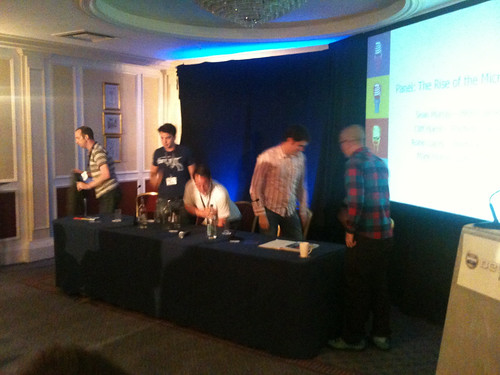
For me it was a ridiculous corporate haranguing in a forum that was about individual personal experiences that really could not be argued with. I know from experience that with a direct approach and engaging with people and meaning it you can get a heck of a lot done. Thats not to see the big guys can easily do that, in fact they are not geared up to do that, but it can make a huge difference. That is the point that was missing for much of the industry still. People are connected, they are bypassing large structures and organising in a different way. The four guys on the panel proved that works as much in the games industry as any other.
****UPDATE To his credit Mark Rein issued an apology and explanation via Develop and to @cliffski. That takes some doing and maybe show there is some interesting middle ground, though small indie and large corporate live by different rules very often.
Anyway after all that many of the key players in the industry went off to an awards dinner where Unity3d got 2 awards including the Grand Prix 🙂 David Helagason was saying as he went off to it he was very nervous, but I am really pleased they did win as they are the shake up the industry needs. Well done to Channel4 for their use of education gaming and getting the hero award too. Brilliant stuff.
Day 3
Successful, Creative, GSOH
Tim Shafer Double Fine
A brilliant opening keynote. Tim is a veteran of the industry and created recent games such as Brutal Legend and before that Psychonauts. However for me he is the creator of Full Throttle and hence can stand up and say whatever he wants. I was not let down as he shared stories in a completely relaxed and suitably irreverent way. In fact the story started with he recounting seeing someone happily vomit in the hotel corridoor on the way back from the bar, without breaking stride. As he said, all these years he has been going wrong being sick in how own room.
He talked about how hard it is do deliver successful multi million dollar games to publishers who quite often will cancel a game in a company reorg. He also talked about how, for some people, to be so into a game development for 4 years may not be a suitable creative outlet.
One of the things he did with his people at his company was take an “amnesia fortnight”. They all went off and did a game jam, 4 teams just came up with 4 ideas and got on with it. Those 4 ideas got parked as they went back to the big development. The team were enthused and sparked and bonded. As it turned out down the line those became the start of a new era of development for the company, working on smaller titles but more of them. So once again small was the new big.
His tales of working with Tim Curry, Jack Black and Ozzy Osbourne were interesting too. He had been warned they were hard to work with, as most stars are. However he found when they were all creating things they all got into it and were great, people just got stand offish when a suit or marketing/PR person arrived in the room 🙂 That rings a few bells.
Time clearly loves his craft and I can see that would permeate any project he was working on. He dealt with some odd questions too, and also got hassled about the fact he had given an interview the day before where he had made a derogatory comment about a leading executive on the production side of the industry. It seemed the crowd were with him on those comments though 🙂 It was a great talk and another inspiration.
3D: The Next Dimension in Gaming
Mick Hocking, SCEE
This presentation was what it said. An exploration of 3D television and displays in gaming, heavily focussed on Sony of course. It was held in a room with a very unusual ceiling. I used this photo as obviously pictures of 3d tv just doesn’t work 🙂

The presenter did a history of 3d, i.e. its been around as long as photography. This quickly zoomed towards the types of polarized and shutter based technology used on screen. The Sony TV’s seem to be active shutter glasses so hence it was indicated this is better as unlike polarized lenses it does not use have the scanline for one image and half for the other.
He explained some of the design and comfort decisions that Sony help people deal with in games. In particular knowing the size of the screen is important. Large to small works, but the other way around the vergence of your eyes when still focussed on the plane of the screen can get painful. i.e. it makes you go too crosseyed. Also with a HUD on the surface of the screen the things in the game can come out and over lap the HUD.
Sony had brought 2 3D screens, stacks of glasses and had the PS3 running some demos. I watched a few seconds of a racing game. As I suspected games are much better than films in this respect. Your brain is ready for the thrills and spills and it was instantly interesting and engaging.
Finally:
Fable III :Story, Cast and Simulation
Peter Molyneux : Lionhead Studios.
Peter turned up a little late but got a live Fable III demo set up. He explained quite often the things that were appalling (his words) in Fable II and how much better Fable III is. To be expected I guess. Still it was good to hear the removing of 2d interfaces, replacing with in context game metaphors such as levelling up being a journey on a road. Also the fact that multiplayer will be a bit more social. As he explained you can meet and marry in world, buy a house together etc. This got a sort of nervous but derisory laugh from the audience, but that sort of engagement is what works in virtual worlds? Not just the very enjoyable fighting and fragging.
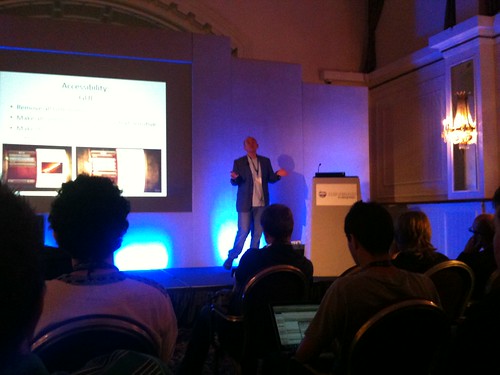
Peter has a lot of critics for being full of spin, but I do like his style and his games are very inventive and enjoyable. Having met and talked with him about virtual worlds and UGC I have a feeling he is on the verge of getting what is going on in the web today, the meet and marry comment alluded to that. However this is still AAA gaming as an industry and it has its patterns and intertia. Seeing the dev version of fable and the hints of LUA scripting etc were quite interesting too. Having cinematics play but Peter saying he was not happy with that move and its being changed etc all good insights.
A very full transcript was taken by Dan Hon, who it was great to see again and who I sat next too through this.
With that I called it a day and came home from Brighton. More enthused than annoyed. Still frustrated the industry is missing out on something rather amazing in virtual worlds, virtual goods, UGC, but also very happy they are not as that give me room to do what I do in this industry too and maybe change it around a little with some of my projects.
Finally I can reveal that the typo on the badges for Evolve was not in fact product placement by CCP as I first thought.

